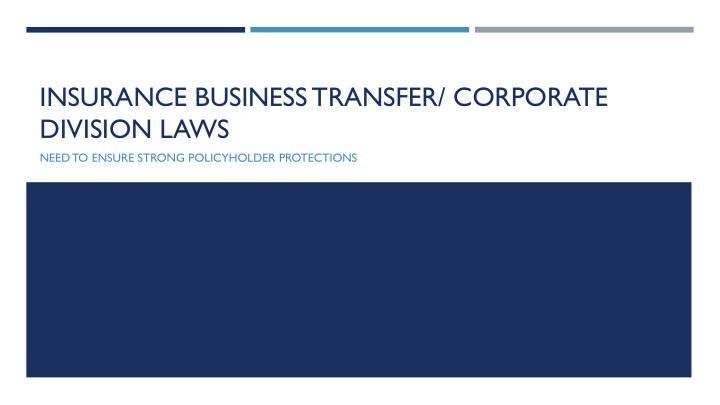



INSURANCE BUSINESS TRANSFER/ CORPORATE DIVISION LAWS NEED TO ENSURE STRONG POLICYHOLDER PROTECTIONS
BACKGROUND Several states have recently enacted laws allowing insurers to transfer business or divide into separate companies for the purposes of separating lines of business; exiting from under-performing, non-profitable business, and creating run-off business. None of these new laws require policyholder consent, nor include many other important policyholder and solvency protections. Historically, state laws have not given insurers authority to divide or transfer policies without consent. Despite posing more risk, these laws also lack many of the important policyholder protections contained in other similar frameworks, such as the UK Part VII Transfer process for insurance business transfer and the US Form A process for mergers and acquisitions. No matter how well intentioned the transaction, any such laws must include important guardrails to ensure that policyholders are not put at risk. The NAIC has acknowledged the increased risks associated with these laws, and recently created a Working Group (which will be chaired by RI and OK) to study the issue.
WHAT ARE THE ISSUES? Currently, in most states… However, under some new state laws… ✓ Insurers must meet all statutory state licensure X Insurers are allowed to pass on financial risk to the rest requirements before taking on insurance risk. of industry by moving unprofitable, long tail, hard to ✓ Insurers meet rigorous statutory solvency standards, value business to a newly formed, and less capitalized including financial analysis and examination to ensure company, making it more likely to fail. they are financially capable of paying claims. X There are no notice requirements to policyholders and ✓ Insurers are held accountable to their policyholders non-domestic regulators when risk is transferred through a statutory enabled insurance regulatory from one entity to another. process. X Despite impacting policyholders in other states, there ✓ Policyholders are notified when business is is no licensure requirement for the newly-formed transferred from one company to another. company, and thus no guaranty association coverage in other states if the business fails. The results could be devastating for the policyholders and the state-based system of insurance regulation.
HOW DOES IT WORK? Insurance division or business transfer laws allow blocks of business to move from one company to a newly-formed company with no policyholder consent. Company B Company A Line 1 Line 1 Line 2 Line 3
WHAT’S THE POTENTIAL IMPACT? A corporate division or business transfer should never allow a company to sidestep promises made to policyholders or shift the financial burden of distressed liabilities onto the guaranty association system. 1 2 3 Policyholders States Insurance Companies • Insurer changed without • No notice and no license • The insurance industry to consent and possibly without requirement for new company in pay guaranty association notice. all states with impacted assessments for failed, • Increased risk for company policyholders. newly-formed companies. insolvency and lack of access • For example, a company can divide • Reputational risk to industry to contracted benefits. and impacted policyholders in due to increase in company • Absence of guaranty other states would find out only failures. association coverage in non- after the fact. domestic states could • Undermines integrity of state overwhelm domestic system of financial regulation. guaranty associations putting policyholders at risk.
WHAT SHOULD BE INCLUDED IN A MODEL LAW OR REGULATION? 1 2 3 Exclusions for financially Strong solvency and Ensure guaranty association troubled and monoline policyholder protections coverage companies 4 5 Policyholder notice and Independent expert consent or a court process review similar to UK Part VII
Questions?
Recommend
More recommend